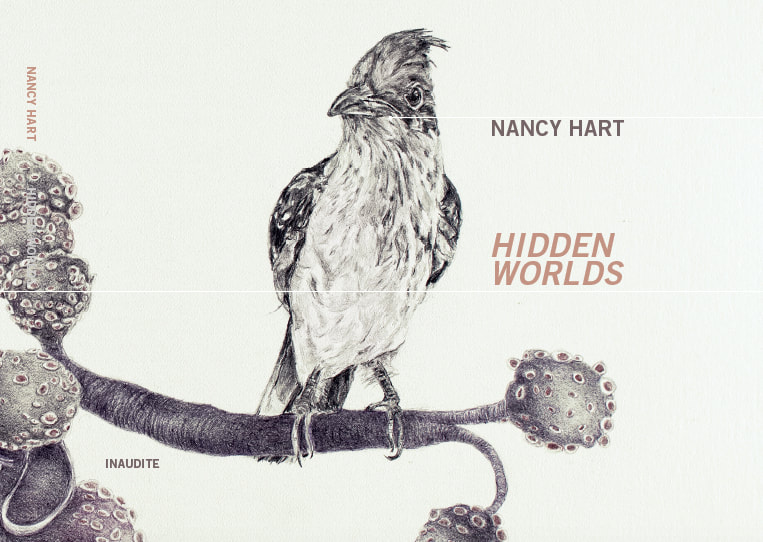|
NANCY HART HIDDEN WORLDS a cura di Barbara Fragogna Artist's BOOK > Prima edizione | in italiano e inglese Formato: 21,5x29cm, 72 pagine, colori, testi e illustrazioni. Impressum Edizioni Inaudite | Collana BIGstuff NA1 - 2021 Nancy Hart | Edizioni Inaudite © Ottobre 2021 Prima edizione: tiratura limitata in 50 copie Prezzo: 30 euro incluse spese di spedizione in Italia scrivere a [email protected] |
NANCY HART HIDDEN WORLDS curated by Barbara Fragogna Artist's BOOK > First Edition | english, italian Size: 21,5x29cm, 72 pages, colors, texts and illustrations. Impressum Edizioni Inaudite | Collana BIGstuff NA1 - 2021 Nancy Hart | Edizioni Inaudite © October 2021 First limited edition of 50 Price: 35 $ delivery included in USA and Europe please write to [email protected] |
“I am interested in the idea of preserving, collecting and displaying birds. They are fixed in a moment in time.” - Nancy Hart
|
Hidden Worlds
by Nancy Hart
I started doing graphite watercolor pencil drawings of larger-than-life single birds from the Venice Museum of Natural History. The display cases were overcrowded with lots of birds but then you turn the corner and go into the galleries you see the birds suspended in flight! They had a lot of negative space around them to give a clean, open effect. At the same time, I was making collage books from editions I bought at the Aqua Alta used bookstore.
In Turin, after drawing the birds, I decided to draw visual collages from photos I had taken of taxidermy birds in natural history museums in Italy and France along with microscopic images of viruses and spores. I created imaginary scenes of life-size birds juxtaposed with scientific forms.
I named the series Hidden Worlds.
by Nancy Hart
I started doing graphite watercolor pencil drawings of larger-than-life single birds from the Venice Museum of Natural History. The display cases were overcrowded with lots of birds but then you turn the corner and go into the galleries you see the birds suspended in flight! They had a lot of negative space around them to give a clean, open effect. At the same time, I was making collage books from editions I bought at the Aqua Alta used bookstore.
In Turin, after drawing the birds, I decided to draw visual collages from photos I had taken of taxidermy birds in natural history museums in Italy and France along with microscopic images of viruses and spores. I created imaginary scenes of life-size birds juxtaposed with scientific forms.
I named the series Hidden Worlds.
|
Nancy Hart – Fatality
A private thought by Barbara Fragogna The first slide that stings my mind always, when I think of Nancy Hart’s birds is the memory of the cadaver of a small blackbird found in the garden of the gallery I directed for a few years in Turin. It was 2017 and Nancy was the guest Artist-in-Residence, the first of three residencies held between 2017 and 2019. I have vivid memories of her burst of happiness upon discovering the dead bird! “I can use it for one of my drawings” she said in US accented Italian, and I thought “Awesome!”. To me, these kinds of almost epiphanic manifestations are scratches of the mark of artistic genius, the vision outside the box (a wonder that for others is horror), the offset point of view (a dead body as a living object), and some madness (“Can I keep it in the fridge?”, “How do I preserve it?” I hear her voice as she says it, laughing in amazement), spontaneous and honest, of those who can see a creative impulse, and of course, the symbolic gesture, everywhere. When we first met, Nancy Hart had already been working on depicting birds using collage, drawing, and the artist’s book for years, but it was in Turin that the taxidermy bird - organic nest combination in the Hidden Worlds series matured and developed. The aesthetic decor of Art Nouveau buildings, the invasive bird songs in parks and backyards, the confrontation with nature, Baroque art, secondhand bookstores, natural science museums, electron microscope scans, Italian American juxtaposition, inner analysis, and molecular introspection are snippets of influences that led Hart’s immobile birds to nest in a magnified microcosm. The drawn birds are transpositions of portraits taken by the artist of embalmed birds exhibited in museums. The choice to start from the immobility and the ineluctability (fatality) of death, from the accomplished fact, from the point of arrival of a certain scientific path, allows the artist to trigger a new life cycle, almost a reincarnation. The animal becomes a symbol and, even if its realistic form predisposes us to an obvious connection, its metaphor allows us to widen our view by extending it towards a more personal, private imagery. The bird is a mine. It is the contemporary dinosaur, the Hitchcockian nightmare, Poe’s raven, transcendence, the soul, a ghost, a flutter of magic, the higher state of consciousness, the power of ascent, and the freedom of flight. The motionless bird is the catharsis of the gesture, its form crystallized in the drawing allows us to look and see, perhaps understand or at least, to intuit. The tangles in which birds roost, nest, and muddle are molecular combinations of viruses and bacteria, of tumor cells and necrotized tissues, inspired mostly by a pathological nature. Here, too, we start from a base that for most people could be defined as negative or deadly, but it is precisely here that banality becomes an exception, discomfort blossoms into a jewel, the alarm sounds a harmonic symphony and corruption reveals its sensual sinuosity. The dark elements, in the visual collage become luminous creations of chiseled beauty. A short-circuit is created and a shock is felt. At the same time, it gives shivers of disquiet and pleasure. An alchemy transmutes objects into subjective mirrors. What makes the figurative work wonderful is its paradoxical capacity for abstraction. You are allowed to see what you exactly desire. I find it incredibly fascinating that this body of work developed between 2017 and 2019, in the years leading up to the SARS-CoV-2 pandemic that has crippled the globe since 2020 and is still ongoing. I am personally inclined to believe that the vocation of the artist is to debate about the present by anticipating its future (whether consciously or unconsciously). The artist’s sensitivity and intelligence are particularly suited to seeing and analyzing the state of things under a certain lens, through a peculiar filter, and I think this idea is embodied in Nancy Hart’s work and oeuvre. Perhaps the most fascinating aspect of this process comes from its unconsciousness. When an artist works, s-he is looking for something that maybe s-he will never find, but in this search, there are steps and passages that are goals, discoveries, revelations, and fundamental pieces of an evolving mosaic. Paper cuts in a potentially eternal collage |
Nancy Hart – Fatalità
Un pensiero privato di Barbara Fragogna La prima diapositiva che mi punge la mente, sempre, quando penso agli uccelli di Nancy Hart è il ricordo del cadaverino di un piccolo merlo trovato nel giardino della galleria che ho diretto per qualche anno a Torino. Era il 2017 e Nancy era l’artista ospite in residenza, la prima di tre residenze svoltesi tra il 2017 e il 2019. Ho vividissimo il ricordo del suo scoppio di felicità alla scoperta del pennuto stecchito! “Posso usarlo per uno dei miei disegni” ha detto in italiano accentato di US, ed io ho pensato “Fantastica!”. Per me questo tipo di manifestazioni quasi epifaniche, sono graffi del marchio del genio artistico, la visione fuori dagli schemi (la meraviglia che per altri è orrore), il punto di vista sfalsato (un corpo morto come un oggetto vivo), un po’ pazzo (“Lo posso tenere in frigo?”, “Come lo conservo?” sento la sua voce mentre lo dice ridendo stupita), spontaneo e onesto, di chi riesce a vedere una pulsione creativa, e ovviamente, il gesto simbolico, ovunque. Quando ci siamo conosciute, Nancy Hart stava già lavorando da anni alla rappresentazione di uccelli attraverso l’uso del collage, del disegno e del libro d’artista, ma è a Torino che è maturata e che si è sviluppata la combinazione uccello tassidermizzato - nido organico nella serie Hidden Worlds. I grovigli estetici dei palazzi stile Liberty, i canti degli uccelli invadenti nei parchi e nei cortili, il confronto con la natura, l’arte barocca, le librerie di seconda mano, i musei di scienze naturali, le scansioni dei microscopi elettronici, la giustapposizione italo-americana, l’analisi interiore, l’introspezione molecolare, sono ritagli di influenze che hanno portato gli uccelli immobili di Hart a nidificare in un microcosmo magnificato. Gli uccelli disegnati sono trasposizioni di ritratti scattati ai volatili imbalsamati ed esposti nei musei. La scelta di partire dall’immobilità e dall’ineluttabilità (fatalità) della morte, del fatto compiuto, dal punto di arrivo di un certo percorso scientifico, permette all’artista di innescare un nuovo ciclo vitale, quasi una reincarnazione. L’animale diventa un simbolo e, anche se la sua forma realistica ci predispone per un ovvio collegamento, la sua metafora ci permette di allargare la visuale protendendola verso un immaginario più personale, privato. L’uccello è una miniera. E’ il dinosauro contemporaneo, l’incubo Hitchcockiano, il corvo di Poe, la trascendenza, l‘anima, uno spirito, un battito di magia, lo stato superiore della coscienza, il potere dell’ascesa, la libertà del volo. L’uccello immobile è la catarsi del gesto, la sua forma cristallizzata nel disegno ci permette di guardare e vedere, magari capire o almeno, intuire. I grovigli nei quali gli uccelli si posano, nidificano, confondono, sono combinazioni molecolari di virus e batteri, di cellule tumorali e tessuti necrotizzati, ispirazioni per la maggior parte di natura patologica. Anche qui si parte da una base che per la maggior parte delle persone potrebbe essere definita “negativa” o mortifera, ma è proprio qui che la banalità diventa eccezione, il disagio fiorisce mutandosi in gioiello, l’allarme suona una sinfonia armonica e la corruzione rivela le sue sinuosità sensuali. Gli elementi bui, nel collage visivo diventano creazioni luminose di una bellezza cesellata. Si crea un cortocircuito e si sente una scossa che allo stesso tempo dà brividi d’inquietudine e piacere. Un’alchimia trasmuta gli oggetti in specchi soggettivi. Ciò che rende meravigliosa l’opera figurativa è la sua paradossale capacità di astrazione. Vedi ciò che desideri. Trovo incredibilmente affascinante che questa serie di lavori si sia sviluppata tra il 2017 e il 2019, negli anni precedenti la pandemia di SARS-CoV-2 che ha paralizzato il globo dal 2020 e tuttora in corso. Sono personalmente propensa a credere che la vocazione dell’artista sia di parlare del presente anticipandone il futuro (sia consciamente che inconsciamente). La sua sensibilità e intelligenza sono particolarmente adatte a vedere e analizzare lo stato delle cose sotto una certa lente, attraverso un filtro peculiare e penso che questa idea si incarni nel lavoro e nell’opera di Nancy Hart. Forse l’aspetto più affascinante di questo processo deriva dalla sua inconsapevolezza. Quando un artista lavora cerca qualcosa che forse non troverà mai, ma in questa ricerca ci sono passi e passaggi che sono traguardi, scoperte, rivelazioni. Tasselli fondamentali di un mosaico in evoluzione. Pezzettini di carta di un potenzialmente eterno collage. |
NANCY A. HART
is a tenured Professor of Art at
The University of Texas Permian Basin.
She lives and works in Odessa, Texas, USA.
is a tenured Professor of Art at
The University of Texas Permian Basin.
She lives and works in Odessa, Texas, USA.

















